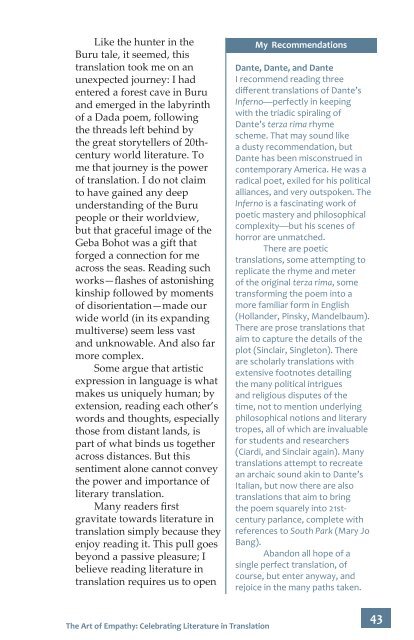The Art of Empathy Translation
The Art of Empathy Translation
The Art of Empathy Translation
You also want an ePaper? Increase the reach of your titles
YUMPU automatically turns print PDFs into web optimized ePapers that Google loves.
Like the hunter in theBuru tale, it seemed, thistranslation took me on anunexpected journey: I hadentered a forest cave in Buruand emerged in the labyrinth<strong>of</strong> a Dada poem, followingthe threads left behind bythe great storytellers <strong>of</strong> 20thcenturyworld literature. Tome that journey is the power<strong>of</strong> translation. I do not claimto have gained any deepunderstanding <strong>of</strong> the Burupeople or their worldview,but that graceful image <strong>of</strong> theGeba Bohot was a gift thatforged a connection for meacross the seas. Reading suchworks—flashes <strong>of</strong> astonishingkinship followed by moments<strong>of</strong> disorientation—made ourwide world (in its expandingmultiverse) seem less vastand unknowable. And also farmore complex.Some argue that artisticexpression in language is whatmakes us uniquely human; byextension, reading each other’swords and thoughts, especiallythose from distant lands, ispart <strong>of</strong> what binds us togetheracross distances. But thissentiment alone cannot conveythe power and importance <strong>of</strong>literary translation.Many readers firstgravitate towards literature intranslation simply because theyenjoy reading it. This pull goesbeyond a passive pleasure; Ibelieve reading literature intranslation requires us to openMy RecommendationsDante, Dante, and DanteI recommend reading threedifferent translations <strong>of</strong> Dante’sInferno—perfectly in keepingwith the triadic spiraling <strong>of</strong>Dante’s terza rima rhymescheme. That may sound likea dusty recommendation, butDante has been misconstrued incontemporary America. He was aradical poet, exiled for his politicalalliances, and very outspoken. <strong>The</strong>Inferno is a fascinating work <strong>of</strong>poetic mastery and philosophicalcomplexity—but his scenes <strong>of</strong>horror are unmatched.<strong>The</strong>re are poetictranslations, some attempting toreplicate the rhyme and meter<strong>of</strong> the original terza rima, sometransforming the poem into amore familiar form in English(Hollander, Pinsky, Mandelbaum).<strong>The</strong>re are prose translations thataim to capture the details <strong>of</strong> theplot (Sinclair, Singleton). <strong>The</strong>reare scholarly translations withextensive footnotes detailingthe many political intriguesand religious disputes <strong>of</strong> thetime, not to mention underlyingphilosophical notions and literarytropes, all <strong>of</strong> which are invaluablefor students and researchers(Ciardi, and Sinclair again). Manytranslations attempt to recreatean archaic sound akin to Dante’sItalian, but now there are alsotranslations that aim to bringthe poem squarely into 21stcenturyparlance, complete withreferences to South Park (Mary JoBang).Abandon all hope <strong>of</strong> asingle perfect translation, <strong>of</strong>course, but enter anyway, andrejoice in the many paths taken.<strong>The</strong> <strong>Art</strong> <strong>of</strong> <strong>Empathy</strong>: Celebrating Literature in <strong>Translation</strong>43


